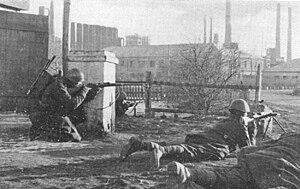Battle of Safashar (1951)
The Battle of Safashar, also known as the Siege of Safashar, was the final major battle of the Domlandian Civil War and is viewed by some historians as the end of the Domlandian Wars of Independence, although many Biggonian historians dispute this. The battle was fought in Safashar, the last major stronghold of the Eastern Biggonia Alliance (EBA) and capital of Khorrambid Prefecture. The battle lasted from early September to mid December, with Domlandian authorities declaring the city cleared of Biggonian fighters on the 13th December and the EBA leadership officially announcing the city as having fallen on the 17th December.
Opposing Forces
Domlandian Republic
Despite incurring substantial losses during the preceding Civil War, by September 1951 the Domlandian Army had reached a new height of strength, especially in terms of material quality and logistical capacity. In fighting immediately outside Safashar during Domlandian efforts to encircle the city, the Domlandian Republic committed 9 divisions, of which several were under full strength, with the final total approximately 60,000 men. Once Domlandia began to advance into Safashar proper, they had assembled a force of 12 divisions, titled the 3rd Domlandian Army Corps.
| Corps | Corps Commander | Division/Unit | Divisional Commander | Divisional Strength (% of peak) |
|---|---|---|---|---|
| III Corps | Field Marshal Zarang Jagdal | 3rd Rifle Division | 11,560 (77%) | |
| 5th Motorised Rifle Division | 8,000 (67%) | |||
| 6th Armoured Division | 3,950 (33%) | |||
| 8th Rifle Division | 9,240 (62%) | |||
| 9th Rifle Division | 2,800 (19%) | |||
| 12th Motorised Rifle Division | 6,260 (52%) | |||
| 13th Armoured Division | 7,310 (61%) | |||
| 14th Shock Division | 5,500 (68%) | |||
| 27th Rifle Division | 13,950 (93%) | |||
| 28th Shock Division | 3,120 (39%) | |||
| 29th Motorised Rifle Division | 12,000 (100%) | |||
| Free Biggonian Brigade | Karl Moshiri | 1,200 (80%) |
Throughout the war the Domlandian Army had enacted major reforms which transformed their previous armed forces which fought in the Domlandian War of Independence against Biggonia into a modern fighting force, utilising an effective and centralised Command and Control system alongside a bureaucratically organised general staff. In spite of these improvements, political inteference still remained in Domlandia's officer corps, especially considering the fact that many new politicians were former members of the military during the War of Independence. This inteference was at its worst after the encirclement of Safashar was concluded, at which point former war hero and current president Ghani Nazaniin began to personally oversee operations to clear the city, causing tension with the official commander of III Corps; Field Marshal Zarang Jagdal.
In terms of strategy, the Domlandian Army's main plan was to first encircle Safashar before mounting a large scale assault to fully clear out the city, in the process killing or capturing the EBA's leadership. It was also hoped that this encirclement and urban assault would lead to most or all of the EBA's remaining forces to be wiped out, bringing the conflict to an end and preventing it from spiraling into a costly guerilla war. However, exact methods differed on how to clear out the urban centres differed. Whilst President Ghani Nazaniin favoured a slower advance, utilising large amounts of artillery to reduce Domlandian casualties, Field Marshal Zarang Jagdal preferred a much faster advance in order to preserve civilian infrastructure and rapidly end the battle by capturing their leaders; along with his own belief that prolonging urban warfare through caution would actually lead to greater casualties in the long run, as he had observed in the gruelling urban sieges which characterised the Domlandian Civil War. Ultimately strategies were mixed, with some sections of the city being taken only after intense artillery bombardments and firefights lasting weeks, whilst others were taken in an afternoon by armoured spearheads supported by infantry.
